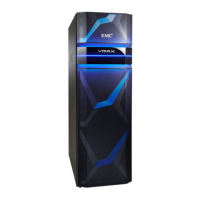Use the removepair and movepair operations to remove/move device pairs.
If all device pairs are removed from the group, the group is no longer controlled by
SRDF/Metro. The group can be re-used either as a SRDF/Metro or non-Metro
group.
l
Deactivate SRDF/Metro
If all devices in an SRDF/Metro group are deleted, that group is no longer be part
of an SRDF/Metro configuration.
You can use the createpair operation to re-populate the RDF group, either for
SRDF/Metro or for non-Metro.
SRDF/Metro resiliency
If a SRDF/Metro device pair becomes Not Ready (NR) on the SRDF link, SRDF/Metro
must respond by choosing one side of the device pair to remain accessible to hosts,
while making the other side of the device pair inaccessible. This response to lost
connectivity between the two sides of a device pair in an SRDF/Metro configuration is
called
bias
.
Initially, the R1 side specified by the createpair operation is the
bias side
. That is, if the
device pair becomes NR, the R1 (bias side) side remains accessible (RW) to hosts, and
the R2 (
non-bias side
) is made inaccessible (NR) to hosts. Bias can be changed once
all the device pairs in the SRDF/Metro group have reached the ActiveActive pair
state. The bias side is represented as R1 and the non-bias side is represented as R2.
l
During the createpair operation, bias defaults to the R1 device. After device
creation, bias side can be changed from the default (R1) to the R2 side
l
The initial bias device will be exported as the R1 in all external displays and
commands.
l
The initial non-bias device will be exported as the R2 in all external displays and
commands.
l
Changing the bias changes the SRDF personalities of the two sides of the SRDF
device pair.
The following sections explain the methods SRDF/Metro provides for determining
which side of a device pair is the winner in case of a replication failure.
Bias
In an SRDF/Metro configuration, HYPERMAX OS uses the link between the two sides
of each device pair to ensure consistency of the data on the two sides. If the device
pair becomes Not Ready (NR) on the RDF link, HYPERMAX chooses the bias side of
the device pair to remain accessible to the hosts, while making the non-bias side of
the device pair inaccessible. This prevents data inconsistencies between the two sides
of the RDF device pair.
Bias applies only to RDF device pairs in an SRDF/Metro configuration.
When adding device pairs to an SRDF/Metro group (createpair operation),
HYPERMAX configures the R1 side of the pair as the bias side.
For example, in Solutions Enabler, use the -use_bias option to specify that the R1
side of devices are the bias side when the Witness options are not used. For example,
to create SRDF/Metro device pairs and make them RW on the link without a Witness
array:
Remote replication solutions
SRDF/Metro resiliency 149

